| Article ID | Journal | Published Year | Pages | File Type |
|---|---|---|---|---|
| 4377466 | Ecological Modelling | 2010 | 8 Pages |
Abstract
A mathematical model of the individual budget of a spawning female of the copepod Acartia grani (Sars) has been used to simulate the time-scale of egg production over various external forcings (or inputs) of food fluctuation conditions. The budget matter in the body of the copepod females is distributed through four compartments: the whole digestive tract (globally named as gut), the hemolymph (which include the body fluid with available nutriments for the organs), the structural body weight, and the gonad. This small calanoid species does not carry lipid reserves but cumulate some labile reserves in its body, according to food availability. The model results show how the continuous spawning varies with food fluctuations, and suggest the mechanisms inducing the delay of response to starvation by using the metabolic reserves. Three different patterns in egg production response are observed: food fluctuations with frequencies below 12Â h have no effect on egg production; food fluctuations of 12Â h to 5 days induce synchronous egg production fluctuations; beyond 5 days the strong physiological changes induced by long starvation durations create delays in the responses to food replenishment. The available data of cultivated cohorts under laboratory conditions are used to validate the model. The properties underlined by the model, in particular its weak capacity to respond to starvation, allow explaining A. grani distribution in specific habitats. Different experimental protocols for complementary experiments are proposed to complete the model validation in other forcing conditions.
Keywords
Related Topics
Life Sciences
Agricultural and Biological Sciences
Ecology, Evolution, Behavior and Systematics
Authors
F. Carlotti, L. Eisenhauer, A. Calbet,
